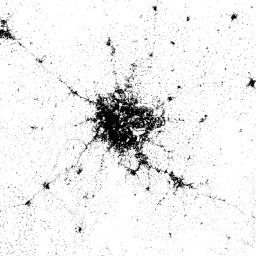
- זמינות מערך הנתונים
- 2015-01-01T00:00:00Z–2016-01-01T00:00:00Z
- ספק מערך נתונים
- Deutsches Zentrum für Luft- und Raumfahrt (DLR)
- תגים
תיאור
הנתונים של World Settlement Footprint (WSF) 2015 הם מסכת בינארית ברזולוציה של 10 מטרים, שמתווה את היקף ההתיישבות האנושית ברחבי העולם. הנתונים האלה נגזרים מתמונות רב-זמניות של Landsat-8 ו-Sentinel-1 משנת 2014 עד 2015 (כ-217,000 סצנות וכ-107,000 סצנות עברו עיבוד, בהתאמה).
הדינמיקה הזמנית של יישובים אנושיים לאורך זמן שונה באופן מובן מזו של כל שאר סוגי המידע שאינם יישובים. לכן, בהינתן כל התמונות הרב-זמניות שזמינות לגבי אזור מסוים במרווח הזמן שנבחר, נתונים סטטיסטיים זמניים מרכזיים (כלומר, ממוצע זמני, מינימום, מקסימום וכו') מחולצים לגבי:
- ערך הפיזור לאחור המקורי במקרה של נתוני רדאר; ו
- מדדים ספקטרליים שונים (למשל, מדד צמחייה, מדד שטחים בנויים וכו') שנגזרים אחרי ביצוע מיסוך עננים במקרה של תמונות אופטיות.
לאחר מכן, מוחלים בנפרד סכימות סיווג שונות שמבוססות על מכונות וקטור תומכות (SVM) על התכונות הזמניות של האופטיקה והמכ"ם, בהתאמה, ולבסוף, שתי התוצאות משולבות יחד בצורה נכונה.
כדי להעריך באופן כמותי את רמת הדיוק והמהימנות הגבוהה של השכבה, בוצע תרגיל אימות נרחב בשיתוף עם Google, על סמך כמות עצומה של דוגמאות של נתוני אמת (כלומר, 900,000) שסומנו על ידי מיקור המונים של פרשנות תמונות. הוגדר פרוטוקול שקוף וחזק מבחינה סטטיסטית, בהתאם לשיטות המומלצות בספרות המקצועית.
לפרטים טכניים מלאים, אפשר לעיין בפרסום.
תחום תדרים
תחום תדרים
| שם | מינימום | מקסימום | גודל הפיקסל | תיאור |
|---|---|---|---|---|
settlement |
255 | 255 | 10 מטרים | אזור התיישבות אנושית |
תנאים והגבלות
תנאים והגבלות
ציטוטים ביבליוגרפיים
Marconcini, M., Metz-Marconcini, A., Üreyen, S., Palacios-Lopez, D., Hanke, W., Bachofer, F., Zeidler, J., Esch, T., Gorelick, N., Kakarla, A., פגניני, מ' (Paganini, M.), Strano, E. (2020). התווית World Settlement Footprint 2015 מציינת את המקומות שבהם בני אדם חיים. Scientific Data, 7(1), 1-14. doi:10.1038/s41597-020-00580-5
מספרי DOI
סיור באמצעות Earth Engine
עורך הקוד (JavaScript)
var dataset = ee.Image('DLR/WSF/WSF2015/v1'); var opacity = 0.75; var blackBackground = ee.Image(0); Map.addLayer(blackBackground, null, 'Black background', true, opacity); var visualization = { min: 0, max: 255, }; Map.addLayer(dataset, visualization, 'Human settlement areas'); Map.setCenter(90.45, 23.7, 7);
